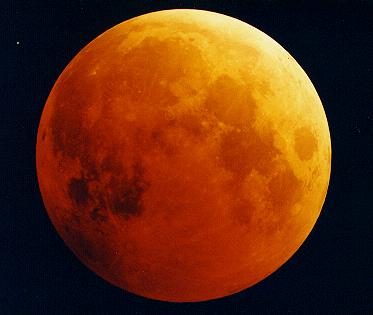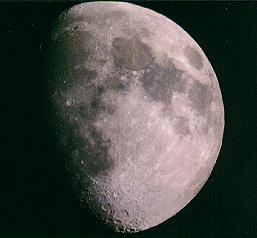
JeffPo's Lunar Page
Last update: 01/21/19
Some of the images you will see below are not all that great. But, they chronicle what I'm trying to do. My biggest problem with lunar shots seem to be from the vibration inflicted by my camera mirror flipping up. I hope to be posting better images as I get around this problem (through better balancing of the scope and maybe doing afocal shots).
Some observers curse the Moon because it floods the sky with light, thereby making observations of deepsky objects almost impossible. I on the other hand, usually turn my scopes on the Moon. The lunar surface is great "eye candy". There's nothing else in the sky that will offer so much detail. You could spend days just getting to know the area around one large crater. I like to focus on one object at a time. I zoom in on a crater, examine it's floor and central peak. I love to see the shadow of the central peak or crater walls, stretching across the crater floor. Another favorite of mine is when a solitary peak in the "night zone" catches the morning sun. It glows like a beacon, surrounded by inky blackness. If you haven't observed the Moon recently, I urge you to rediscover it.

This image is the total lunar eclipse of Sept. 26, 1996. Taken with 8" f/10 SCT, prime focus, 200asa film, ~10 seconds. The star to the upper left is SAO 109142, an 8th magnitude star that was later occulted. This is my best total lunar eclipse shot (09/26/96). I also had some pretty good shots of the April 3 lunar eclipse, but the September shots are the best. The scanned image is not quite as good as the print because it is in low resolution. I have an 8x10 picture of this image on my bookshelf at home.

This 1st Quarter moon shot was my first attempt at lunar photography. I used the afocal method of placing the camera on a tripod, and putting it up to the eyepiece on the telescope. The scope was my 80mm Vixen refractor with 910mm focal length and 27mm eyepiece. The exposure time was 1/30 second. The film speed was either 100 or 200 asa (can't remember).

This image was taken using the same method as above except with a 12mm eyepiece and a 1/15th second exposure time.

This image was taken at the prime focus of the Vixen 80mm refractor. Notice the crater Tycho, and its ray system at the bottom center of the Moon.

Lunar crater Arzachel (middle bottom) and crater Alphonsus (middle top). Notice the central peaks and the shadow of the crater rim lying on the crater floor. Part of the large crater Albategnius (and it's central peak) can be seen in the upper right of the picture.

Here's an afocal shot of the moon taken through my 10" f/4.5 Newtonian. You can see the crater Copernicus to the left of center. You can see the crater Tycho toward the bottom of the Moon.

Here's a closer view of the crater Tycho taken through the 10" f/4.5 newtonian via the afocal method.

Here's an afocal shot of a waning gibbous moon (i.e. just before 3rd quarter) taken through the 80mm refractor.

Here you see the mighty crater Clavius (that big joker to the right of center), waking up to a lunar morning. The rims of the crater have the early morning light, while the floor of the crater hangs onto the darkness of night. Sorry, but I can't remember how I took this image.

This is an afocal shot of the moon when it was two days past full. This was done on my 80mm Vixen refractor. Notice the prominent crater Langrenus to the lower right. That's in Mare Fecunditatis. The circular sea above it, on the right middle edge of the moon, is Mare Crisium.

Here's a zoomed in shot of the Copernicus crater taken via eyepiece projection through the 8" SCT.

Here's an image of the Total Lunar Eclipse that occurred on the evening of January 20, 2000. This shot was taken at the prime focus of my 8" f/10 SCT. It was about a 7 second exposure on 200asa film. I almost froze my tail feathers off taking this picture! Compare this shot to the lunar eclipse at the top of the page. Notice that this eclipse has the lighter portion of the Earth's shadow toward the southern hemisphere of the moon while the other eclipse at the top of the page has the lighter portion of the shadow in the northern hemisphere.
Digital Camera Images
Since I've been hearing about other people's success with digital cameras, I've decided to try my hand at it too. I'm using a Nikon 995 camera attached afocally to my telescope (mainly, the 8" SCT). So far, the results haven't been as good as I expected. The problem is less than sharp images. Although the image in the eyepiece or view screen looks sharp, it doesn't turn out that way in the picture. I think it's a problem with unstable air (i.e. bad seeing). That's probably why a lot of people take multiple images and "stack" them together. I'll give that a try sometime in the near future. Meanwhile, you'll find my single image digital snapshots below.

This image has the great crater Tycho in the center. Mighty Clavius is to the left of Tycho.

This image has the Copernicus crater in the center.

This image shows the Apenninus mountain range.

This image has the crater Bullialdus in the center.

This image has the crater Plato in the center.

Total lunar eclipse of September 27, 2015. Prime focus of my 80mm refractor, digital SLR camera. This is a horrible image, but I'm putting it here as documentation of observing the eclipse. The weather report wasn't good. It was overcast and raining for most of the day. I figured the eclipse was going to be washed out, so I didn't even plan on setting up anything. When I glanced out the window and could see the moon through haze and clouds, I rushed outside to observe it. Snapping an image was an afterthought. The non-guided refractor produced blurry images, and I'm sure the mirror slap didn't help either. My beautiful wife and I observed the eclipse with binoculars from our front porch. In fact, I think lunar eclipses are best viewed with the naked eye and binoculars. For some reason a telescopic view of an eclipsed moon just doesn't look all that great. I think it's because you lose the contrast between the moon and the surrounding sky.
Total lunar eclipse of January 20-21, 2019. Prime focus of my 80mm refractor, digital SLR camera, about a 2 sec. image. My wife Lynn and I braved the frigid cold and wind last night to take a glimpse at the total lunar eclipse. Had it not been so windy, cold, and late, I would have setup my better equipment for a nicer picture. But even a blurry snapshot is still a great representation of this spectacular celestial phenomenon. For an astronomy recap, a lunar eclipse is when the moon passes through the earthís shadow (as cast by the sun). While that perfect line up doesnít happen all that often, the earthís shadow is rather large, thus lunar eclipses can be in totality for about an hour. This also means that during the lunar eclipse, if the moon is up, and itís not cloudy, everyone can see it. So as those of us in Raleigh were looking at the eclipsed moon high overheard, those out on the west coast were seeing it at the same time, though over their eastern horizon.
During a total lunar eclipse, the earth blocks all the direct light from the sun hitting the moon. The reason the moon takes on a deep reddish glow, and the reason the color isnít uniform across the lunar surface (i.e. the edges are a lighter color) is because the light you are seeing is light that has been refracted by the earthís atmosphere. Itís the same reason sunsets and sunrises have red skies. Another neat effect is that while the moon is eclipsed, the stars come out to play! Generally a full moon lights up the sky so much that only the brighter stars are prominent. With the darkened moon, all the fainter stars, star clusters, and such are visible. With binoculars I could see the Beehive cluster in Cancer, just to the left of the moon, as well as various other star clusters through the sky. Even briefly glanced at the Orion Nebular. Awesome experience!